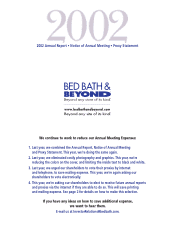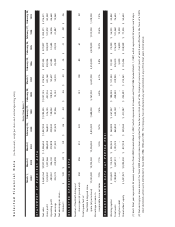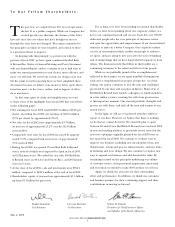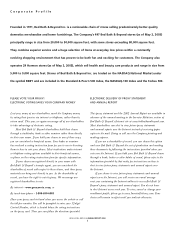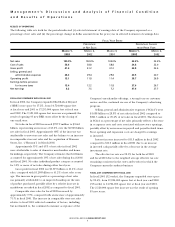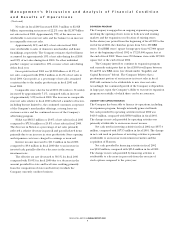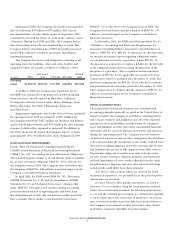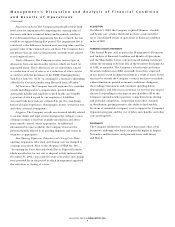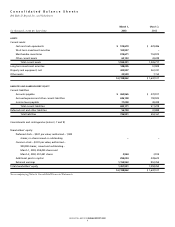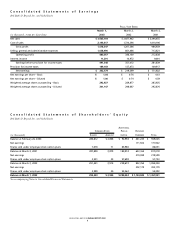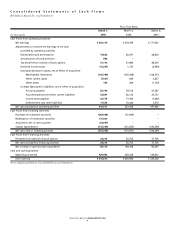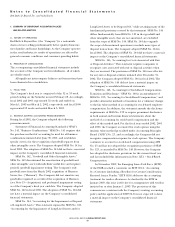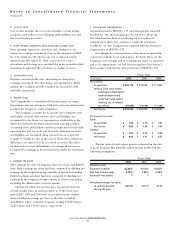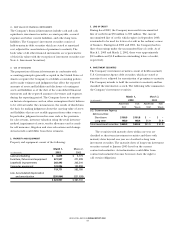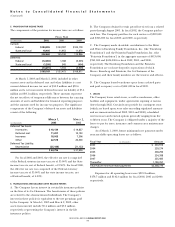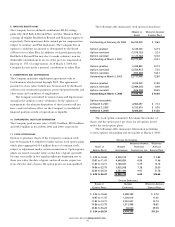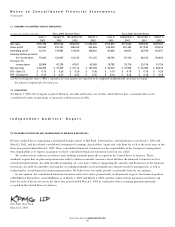Bed, Bath and Beyond 2002 Annual Report Download - page 8
Download and view the complete annual report
Please find page 8 of the 2002 Bed, Bath and Beyond annual report below. You can navigate through the pages in the report by either clicking on the pages listed below, or by using the keyword search tool below to find specific information within the annual report.
BED BATH & BEYOND ANNUAL REPORT 2002
6
Impairment of Assets: The Company periodically reviews long-
lived assets for impairment by comparing the carrying value of
the assets with their estimated future undiscounted cash flows.
If it is determined that an impairment loss has occurred, the loss
would be recognized during that period. The impairment loss is
calculated as the difference between asset carrying values and the
present value of the estimated net cash flows. The Company does
not believe that any material impairment currently exists related
to its long-lived assets.
Vendor Allowances: The Company receives various types of
allowances from our merchandise vendors, which are based on
negotiated terms. These allowances are recorded when earned
as a reduction of cost of sales or as a reduction of other costs in
accordance with the provisions of the FASB’s Emerging Issues
Task Force Issue No. 02-16 “Accounting by a Customer (Including
a Resale) for Certain Consideration Received from a Vendor.”
Self Insurance: The Company uses self insurance for a number
of risks including worker’s compensation, general liability,
automobile liability and employee related health care benefits
(a portion of which is paid by our employees). Liabilities
associated with these risks are estimated in part by considering
historical claims experience, demographic factors, severity factors
and other actuarial assumptions.
Litigation: The Company records an estimated liability related
to various claims and legal actions arising in the ordinary course
of business which is based on available information and advice
from outside counsel, where appropriate. As additional
information becomes available, the Company reassesses the
potential liability related to its pending litigation and revises its
estimates as appropriate.
Store Opening, Expansion, Relocation and Closing Costs: Store
opening, expansion, relocation and closing costs are charged to
earnings as incurred. Prior to the adoption of SFAS No. 146,
“Accounting for Costs Associated with Exit or Disposal Activities,”
which was effective for any exit or disposal activity initiated after
December 31, 2002, costs related to store relocations and closings
were provided for in the period in which management approved
the relocation or closing of a store.
ACQUISITION
On March 5, 2002, the Company acquired Harmon, a health
and beauty care retailer, which did not have a material effect
on its consolidated results of operations or financial condition
in fiscal 2002.
FORWARD LOOKING STATEMENTS
This Annual Report and, in particular, Management’s Discussion
and Analysis of Financial Condition and Results of Operations,
and the Shareholder Letter, contain forward looking statements
within the meaning of Section 21E of the Securities Exchange Act
of 1934, as amended. The Company’s actual results and future
financial condition may differ materially from those expressed
in any such forward looking statements as a result of many factors
that may be outside the Company’s control. Such factors include,
without limitation: general economic conditions, changes in
the retailing environment and consumer spending habits,
demographics and other macroeconomic factors that may impact
the level of spending for the types of merchandise sold by the
Company; unusual weather patterns; competition from existing
and potential competitors; competition from other channels
of distribution; pricing pressures; the ability to find suitable
locations at reasonable occupancy costs to support the Company’s
expansion program; and the cost of labor, merchandise and other
costs and expenses.
SEASONALITY
The Company exhibits less seasonality than many other retail
businesses, although sales levels are generally higher in August,
November and December, and generally lower in February
and March.
Management’s Discussion and Analysis of Financial Condition
and Results of Operations
(Continued)

